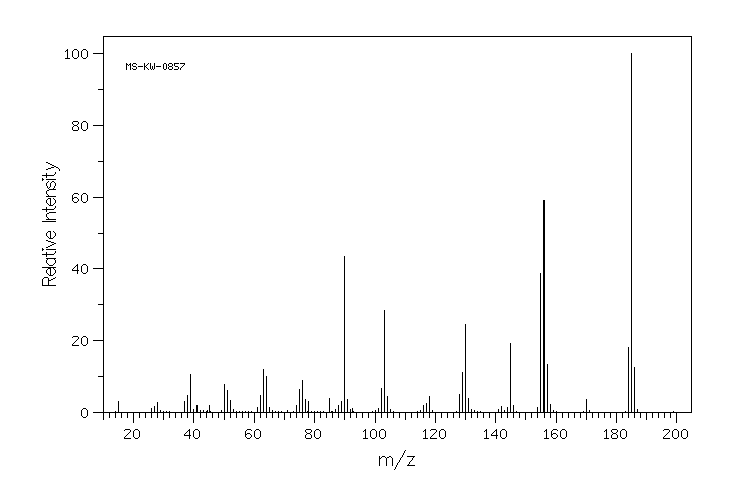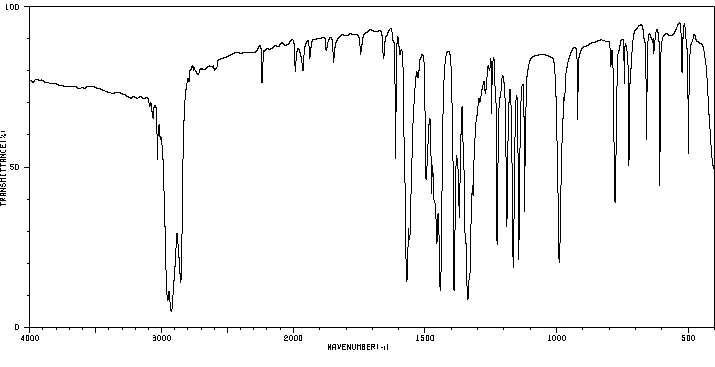3-methoxy-2-quinoxalinecarbonitrile | 90800-74-1
中文名称
——
中文别名
——
英文名称
3-methoxy-2-quinoxalinecarbonitrile
英文别名
3-methoxyquinoxaline-2-carbonitrile;3-methoxy-quinoxaline-2-carbonitrile;3-Methoxy-chinoxalin-2-carbonitril;3-Methoxyquinoxaline-2-carbonitrile
CAS
90800-74-1
化学式
C10H7N3O
mdl
——
分子量
185.185
InChiKey
PKJDXVGBNQGQLO-UHFFFAOYSA-N
BEILSTEIN
——
EINECS
——
-
物化性质
-
计算性质
-
ADMET
-
安全信息
-
SDS
-
制备方法与用途
-
上下游信息
-
文献信息
-
表征谱图
-
同类化合物
-
相关功能分类
-
相关结构分类
物化性质
-
沸点:355.7±37.0 °C(Predicted)
-
密度:1.30±0.1 g/cm3(Predicted)
计算性质
-
辛醇/水分配系数(LogP):1.6
-
重原子数:14
-
可旋转键数:1
-
环数:2.0
-
sp3杂化的碳原子比例:0.1
-
拓扑面积:58.8
-
氢给体数:0
-
氢受体数:4
反应信息
-
作为反应物:描述:丁酸酐 、 3-methoxy-2-quinoxalinecarbonitrile 在 氢气 作用下, 以 四氢呋喃 为溶剂, 50.0 ℃ 、344.75 kPa 条件下, 反应 7.0h, 以9%的产率得到N-(3-methoxyquinoxalin-2-ylmethyl)butyramide参考文献:名称:New Quinoxaline Derivatives as Potential MT1 and MT2 Receptor Ligands摘要:自从有人提出褪黑素可能促进睡眠并重新同步昼夜节律以来,许多研究团队一直致力于获得新的褪黑素受体配体,其药效基团包括一条可变长度的脂肪链,与N-烷基酰胺和一个甲氧基团(或生物等排体)相连,连接在一个中心环上。将褪黑素中的吲哚环替换为萘环或喹啉环会得到亲和力相似的化合物。下一步,在这种结构逼近中,将引入一个喹喔啉环(喹啉环和萘环的生物等排体)作为未来褪黑素能配体的中心核。DOI:10.3390/molecules17077737
-
作为产物:描述:参考文献:名称:New Quinoxaline Derivatives as Potential MT1 and MT2 Receptor Ligands摘要:自从有人提出褪黑素可能促进睡眠并重新同步昼夜节律以来,许多研究团队一直致力于获得新的褪黑素受体配体,其药效基团包括一条可变长度的脂肪链,与N-烷基酰胺和一个甲氧基团(或生物等排体)相连,连接在一个中心环上。将褪黑素中的吲哚环替换为萘环或喹啉环会得到亲和力相似的化合物。下一步,在这种结构逼近中,将引入一个喹喔啉环(喹啉环和萘环的生物等排体)作为未来褪黑素能配体的中心核。DOI:10.3390/molecules17077737
文献信息
-
Quinoxalines. XXVII. The cyanation of 2-substituted quinoxaline 4-oxides with trimethylsilyl cyanide.作者:Chihoko IIJIMA、Akira MIYASHITADOI:10.1248/cpb.38.661日期:——The deoxy-cyanation of 2-substituted quinoxaline 4-oxides (Ia-k) with trimethylsilyl cyanide in the presence of 1, 8-diazabicyclo[5.4.0]undec-7-ene gave the corresponding 3-substituted 2-quinoxalinecarbonitriles (IIa-k). However, in the case of 2-(p-tolylsulfonyl)quinoxaline 4-oxide (II), the substitution with cyanide ion proceeded together with deoxy-cyanation to give 2, 3-quinoxalinedicarbonitrile (III).
表征谱图
-
氢谱1HNMR
-
质谱MS
-
碳谱13CNMR
-
红外IR
-
拉曼Raman
-
峰位数据
-
峰位匹配
-
表征信息
同类化合物
(12羟基吲[2,1-b〕喹唑啉-6(12H)-酮)
黑暗猝灭剂BHQ-3,BHQ-3NHS
鸭嘴花酚碱
鸭嘴花碱酮;(S)-2,3-二氢-3,7-二羟基吡咯并[2,1-b]喹唑啉-9(1H)-酮
鸭嘴花碱酮
鸭嘴花碱盐酸盐
鲁米诺单钠盐
鲁米诺
骆驼蓬碱
颜料蓝64
颜料蓝60
顺式-卤夫酮
顺式-(喹喔啉-2-基)丙烯腈1,4-二氧化物
非奈利酮
青黛酮
雷替曲塞杂质1
阿法替尼杂质J
阿法替尼杂质I
阿法替尼杂质28
阿法替尼杂质18
阿法替尼杂质13
阿法替尼杂质
阿法替尼中间体
阿法替尼
阿法替尼
阿朴藏红
阿巴康唑
阿夫唑嗪杂质A
阿夫唑嗪杂质
阿夫唑嗪EP杂质C
阿夫唑嗪
阿喹司特
阿呋唑嗪杂质
阿呋唑嗪杂质
铜迈星
铁诱导细胞死亡激活剂
钠四丙基硼酸酯
酸性蓝98
酸性红101
酮色林醇
酞联氮基[2,3-b]酞嗪-5,14-二酮,7,12-二氢-
酞嗪-5-羧酸
酞嗪-2-氧化物
酚藏花红
酚嗪
酒石酸溴莫尼定
邻苯二甲酰肼
还原黄6GD
还原蓝6
达尼喹酮








